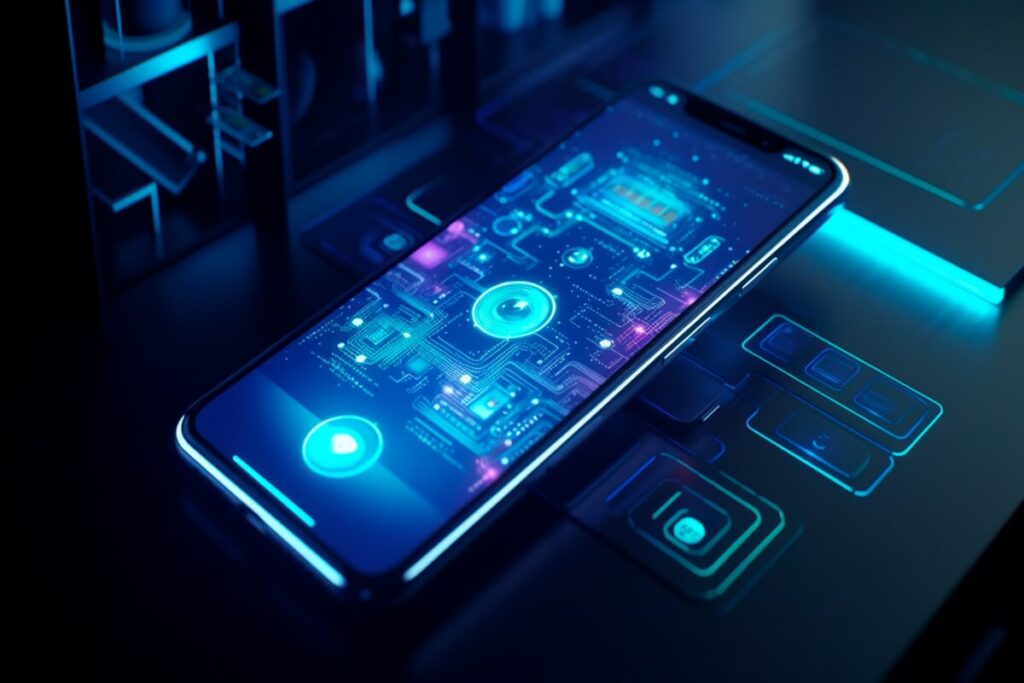As we navigate through the digital age, staying updated with the latest mobile app development trends is of paramount importance. This blog aims to shed light on the evolving landscape of mobile application development and the key trends that are set to redefine this space in 2024. As developers or businesses, understanding these trends can provide a competitive edge and enable you to create innovative, relevant, and effective mobile applications that meet user expectations and drive your success in the digital realm. So, without further ado, let’s dive into the top trends shaping the future of mobile app development.
Trend 1: AI and Machine Learning
Artificial Intelligence (AI) and Machine Learning (ML) are currently at the forefront of mobile app development trends, revolutionizing the way we interact with applications. AI and ML bring advanced functionalities to apps, such as predictive analysis, natural language processing, and personalized recommendations, thereby enhancing the user experience. For instance, AI-powered chatbots in business apps offer superior customer service by providing real-time, personalized responses. Similarly, ML algorithms can analyze user behavior to deliver tailored content, fostering user engagement and loyalty. Looking towards 2024, we expect the integration of AI and ML into mobile apps to become more prevalent. This integration will create more intuitive and smarter applications that can learn from and adapt to user behavior.
Trend 2: Internet of Things (IoT)
Mobile apps are increasingly integrating Internet of Things (IoT) devices, driving a new wave of innovation. From smart homes to healthcare, IoT is connecting the physical and virtual worlds in ways we could hardly imagine just a few years ago. By 2024, we can expect to see more mobile apps leveraging IoT to provide seamless, interconnected experiences.
In the retail industry, IoT-powered mobile apps enhance the shopping experience. They provide personalized recommendations and real-time alerts for promotions or out-of-stock items. In healthcare, IoT sensors and devices collect health data. They transmit it to mobile apps for better patient monitoring and management.
The integration of IoT with AR and VR technology will further enhance the capabilities of mobile apps. For example, IoT-enabled smart glasses can display real-time data and augmented information to users, making tasks more efficient and accurate.
Trend 3: Augmented Reality (AR) and Virtual Reality (VR)
AR and VR technologies have begun to significantly transform the landscape of mobile app development. AR enriches the user experience by overlaying digital information onto the physical world, while VR creates a fully immersive, computer-generated environment that allows users to interact with digital elements realistically.
According to Grand View Research, the global AR and VR market is projected to reach an impressive USD 59.96 billion this year, with a Compound Annual Growth Rate (CAGR) of 27.5% forecasted from 2023 to 2030.
Successful mobile apps such as Pokémon Go (AR-based) and Oculus (VR-based) highlight the immense potential of these technologies in the app development arena. As we progress, we anticipate a surge in AR and VR applications across various sectors including gaming, retail, education, and healthcare.
The growing accessibility of AR and VR devices offers developers an exciting opportunity. It allows them to create more immersive and interactive mobile apps, unlocking possibilities for users.
Consequently, we foresee a rise in demand for developers proficient in these technologies in the coming years. Developers who keep their skills updated and adapt to the rapid evolution of AR and VR will remain competitive. By 2024, AR and VR will likely become even more integral to mobile app experiences, as these technologies continue to blur the lines between the physical and digital worlds.
Trend 4: 5G Technology
The advent of 5G technology is set to dramatically enhance the way we develop mobile apps. As the successor to 4G, 5G technology promises faster speeds, lower latency, and greater capacity, enabling more seamless mobile experiences. This breakthrough is significant in streaming, gaming, and augmented reality (AR) apps. High-speed and real-time data transfer are critical in these realms. Developers are poised to leverage this technology to build mobile apps that are more responsive, reliable, and immersive. It ultimately pioneers a new era of mobile connectivity. As 5G technology becomes mainstream, we can expect a wave of innovation in mobile app development, revolutionizing our digital ecosystem.
5G technology is set to dramatically increase the speed and efficiency of mobile apps. The faster, more reliable connectivity will enable more complex, data-intensive applications, opening up new possibilities in areas like streaming, gaming, and real-time collaboration. By 2024, 5G could be the new norm, shaping the development and use of mobile apps.
Trend 5: Blockchain Technology
Blockchain technology is poised to bring transformative change to mobile app development. Known for its decentralization, transparency, and tamper-evident nature, blockchain can add trust and security to apps. As we integrate blockchain technologies into mobile apps, new opportunities for peer-to-peer interactions, transparent record-keeping, and digital ownership emerge. By 2024, blockchain could redefine how we envision, develop, and use mobile apps, making it a trend worth watching for every forward-thinking developer, including the best mobile app developer.
Conclusion
In conclusion, the trends in mobile app development are evolving at a breakneck pace, dramatically reshaping our digital landscape. From the integration of AI to the emergence of 5G and blockchain, a surge of innovative, user-centric applications is imminent. These advancements enhance our day-to-day lives. With these trends, the future of mobile app development holds great promise, paving the way for a more connected and technologically advanced era. Contact us today to learn how we can help you stay ahead of the game in mobile app development.
